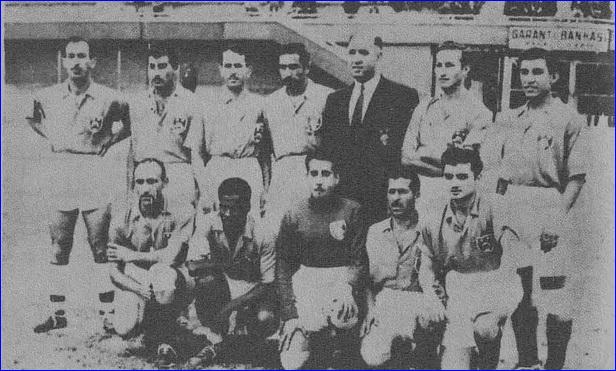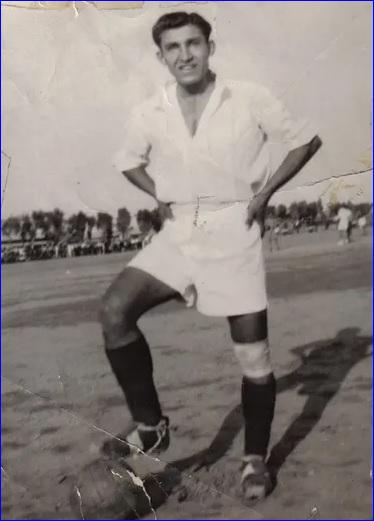


Many years later I contacted the ex-footballer, and through him it seemed as if everything fell into place. He had spent the best part of 60 years living outside Iraq so no one knew what had happened to the centre-half of Iraq's first national side.
Sahib Abbas before playing in a friendly for Iraq at the Al-Shaab stadium in Baghdad. The striker scored three goals in 14 appearances for the national team.
This is how it all began: the sons of a former British army officer, an Eastern Orthodox priest, and an Assyrian Levy soldier were the three men who shaped the side.
The team was formed like the modern-day nation of Iraq, shaped from the old Ottoman vilayets of Baghdad, Basra, and Mosul. There was the outside-left Percy Lynsdale from Baghdad, Basrawi centre-half Saeed Easho and the Mosul-born inside-left Aram Karam.
Saeed was the son of an Eastern Orthodox priest who retired at the age of 23 to pursue a career in engineering. Only four months after pulling on the Iraqi jersey, Saeed left to study at Loughborough College in Leicestershire, England. He enrolled in September 1951, and at the time there were teachers from Sheffield taking courses at the college.
They had heard about the Iraqi national team player and, knowing the management at Sheffield United were searching for players, they got in touch with the club and informed them about the centre-half.
During the Christmas holidays, Saeed received a telegram from the Sheffield club. They had offered him a trial. So off he went with a fellow Iraqi student and they travelled 52 miles north to Bramall Lane. On Christmas Day, the Sheffield United 'A' side were at home and took on Barnsley in the Yorkshire Football League. The 23-year-old Iraqi electrical engineering student from Loughborough College played the 90 minutes as they won 5-4 and after the game the management called him over and asked if he would join.

The talented Percy Lynsdale was one of only a handful of British footballers at the time playing for Iraqi teams in Basra such as Al-Minaa and B.P.C. However, Iraq-born Percy, being the son of an Iraqi-naturalised father of English origin and an Iraqi mother, was eligible to play for Iraq. He became Iraq's very own Tom Finney, the famous outside-right of Preston North End, who played for England in the 1950s.
Percy had not been forgotten by officials from Baghdad's ministry of education when he had captained the Baghdad College team in his senior year. He had studied at the Jesuits Baghdad College on the east bank of the Tigris river, with Percy having been one of the first names on the school team. He had been one of the boys who had spent his afternoons kicking a ball on school grounds, throwing down their jackets as goalposts, which were later replaced with benches.
It was only after the intervention of one of the physics professors, who feared students would start taking chairs from classrooms for goalposts, that actual goalposts were built with a football field. In his senior year, Percy, the team's top scorer and key player in attack at inside-left, captained the side and was one of six players that year inducted into the school's hall of fame.
At the age of 23, Percy, a regular with the B.P.C. side and Basra Select team, was called into the Iraqi national team and played in every one of Iraq's four matches in 1951. But after a season with Al-Minaa, Percy, like his teammate Saeed Easho, decided to retire from football and return to the land of his forefathers to study. Percy arrived in England in 1952 and after dropping out of college he eventually settled in Manchester, where he worked as a self-employed market trader. He died in Chorley in 1997.
The third player was Habbaniya-based Aram Karam, an extraordinary footballer known for his uncanny ability to score from whatever angle or distance with either foot. He was a player, a coach, team captain and goalscorer -- rare in any part of the world.
Aram was an ethnic Assyrian, a descendent of the original inhabitants of ancient Mesopotamia. His ancestors originated from Zangelan in the village of Qatouna, in the north-west of what was then the Persian Empire (now west Azerbaijan province of Iran). His father's family were forced to flee their home to seek refuge under the protection of the British army stationed in Hamadan after Russian forces withdrew and the Ottoman army entered the region and massacred thousands of Assyrians and Armenians.
The son of a Levy soldier, he was brought up in the Levy Family Lines on RAF Station Hinaidi, the second eldest in a family of seven children. Aram was the footballer's footballer, forming his own football team on the RAF base in Habbaniya.
Aram was a talented and technically gifted outside-left who had the vision and ability to dictate any game. When called up by the Iraq Football Association, he had earned a reputation as an outstanding goalscorer in Habbaniya and teams would travel to the RAF base to get the player to guest for sides as kind of a hired gun.
Aram was regarded by many who saw him play as one of the finest and most accomplished finishers of the 1950s and on Iraq's tour of Turkey in 1951 he scored four goals in the team's second international game against an Ankara Select side.
The story of the first Iraqi team and its players is now a distant memory. As revolutions, wars and sanctions passed, Iraqi football's subsequent generations had forgotten their triumphs and defeats and even their names. That did not seem right.
This is an edited extract from Birth of the Lions of Mesopotamia. Click here to order a copy.

or register to post a comment.